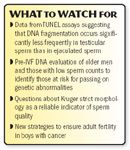Article
Molecular biology reshaping approach to infertility
Many standard laboratory techniques could soon become clinical practice for the diagnosis and treatment of male infertility.

Key Points

"Increasingly, the research being conducted in this area of urology is hastening the day when we will regularly order TUNEL assays on human sperm to check for DNA fragmentation, for example" said Craig S. Niederberger, MD, chief of andrology at the University of Illinois, Chicago. "These are classic lab techniques that are now being used in clinical medicine."
Researchers recently used TUNEL (deoxyribonucleotidyl transferase-mediated dUTP nick-ended labeling) assays to compare DNA damage in sperm retrieved from the testicle with ejaculated sperm. Results suggested that DNA fragmentation occurs significantly less frequently in testicular sperm.
An ongoing concern is that men with low sperm counts might pass on chromosomal abnormalities to their offspring through the use of artificial reproductive techniques such as in vitro fertilization.
"First, we need to continue to pay attention to the genetics of the offspring of IVF," Dr. Niederberger said. "Second, we need to develop techniques to study infertile men so that we ensure we're giving their children the best chance for genetic health."
One such technique is fluorescence in-situ hybridization (FISH) of germ cells with chromosomal probes, which can be used to identify chromosomal aneuploidy as a cause of male infertility. One group has suggested that patients with oligoasthenoteratozoospermia should be offered FISH prior to undergoing IVF/intracytoplasmic sperm injection.

"These men may have normal karyotypes, but you only need to dig a little deeper to find chromosome micromosaicism in about one-third of them," noted Dr. Niederberger. "As the tools to investigate sperm DNA improve, we're finding that male fertility really does change as men age."
Also changing is the basic clinical practice of urology in relation to male fertility issues. For instance, mounting evidence suggests that Kruger strict morphology (KSM), long a staple of fertility analysis, isn't always the most reliable method for determining sperm quality. A comparison of fertile and infertile men found that men with proven fertility have a high frequency of abnormal KSM that is not significantly different from that of infertile males.
Even the question of how long a man should wait to have unprotected sex following a vasectomy is still up for debate. One set of data suggests that a single azoospermic semen sample 16 weeks post-vasectomy is sufficient for clearance.
"Urologists are always concerned about how to counsel patients after vasectomy," Dr. Niederberger said. "This is an important question for those in clinical practice."
Some attention also has been paid recently to the effect of childhood cancers on fertility. Adult male survivors of Hodgkin's disease and rhabdomyosarcoma and those who received high levels of cyclophosphamide (Cytoxan), for example, are at increased risk of testicular dysfunction later in life.
"We need to remind medical oncologists that, down the road, men will want to have children," Dr. Niederberger said. "We need to think about options that preserve gametes prior to treatment for cancer that could potentially damage sperm in a lifelong fashion."





